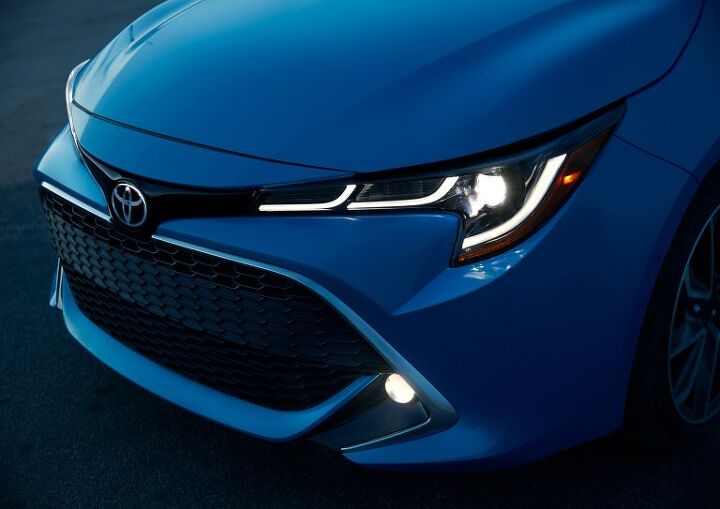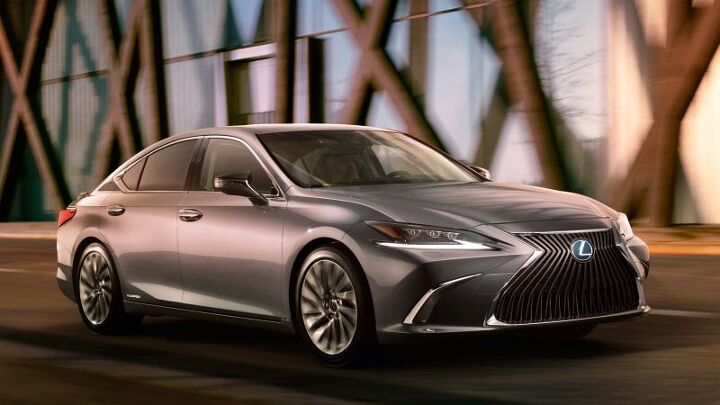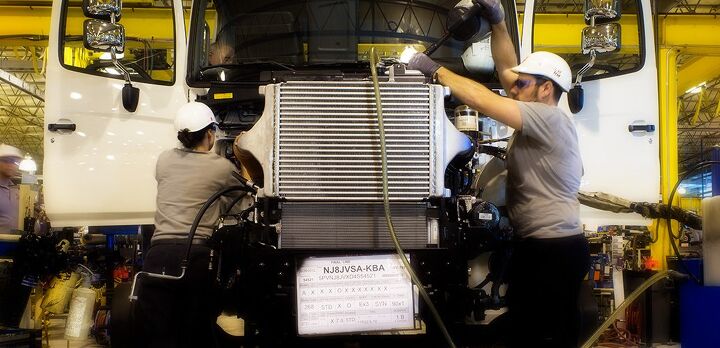#ToyotaMotorCorp
Toyota Building New SUV in Alabama, Not the Corolla
Toyota Motor Corp announced on Wednesday it would be building a new sport utility vehicle at its $1.6 billion joint venture assembly plant in Alabama, rather than the Corolla. This brings its strategy in line with Mazda, which announced it would also be building an SUV at the facility earlier this year.
Officially, Toyota said the change was due to “changing market demands and a growing consumer appetite for light trucks and SUVs,” while slipping in a mention of how well the RAV4 has been selling for good measure.
Toyota Spending $2 Billion to Develop Electric Cars in Indonesia
Having recently announced plans to “popularize” battery electric vehicles, Toyota now expects half of its global volume to stem from electrified cars by 2025. That’s five years sooner than originally promised.
Toyota may seem perpetually averse to change but it has been making a lot of moves behind the scenes to ensure it’s at the forefront of a shifting market while also trying to future proof itself in the event that electrification winds up being a dead end. The plan is rather complex and, as I don’t want to re-write a 900-word article, I would like to redirect you to the relevant information.
However, as nuanced as Toyota’s overall strategy may be, the company is still going to need to spend truckloads of cash to remain in the game. With that in mind, the Japanese automaker appears to be investing $2 billion to develop electric vehicles in Indonesia over the next four years — with hybrids being first on the docket.
Toyota Ramps Up Electrification Timeline, Outlines Nuanced Strategy
Following announcements that Toyota would be working on a shared electric vehicle platform with Subaru, as well as a jointly developed crossover, the brand conducted a press conference on Friday regarding its decision to “popularize BEVs.” While the announcement didn’t deal with the specifics of cutting-edge tech, auxiliary business opportunities, or even a total shift toward battery electric vehicles, it did represent a major commitment from a manufacturer that’s notoriously cautious in its decision making.
Opening the conference, Executive Vice President Shigeki Terashi focused largely on the challenges of electrification. Terashi said Toyota’s intent has always been to support “social progress” and curb CO2 emissions while acknowledging that it had only made formal commitments to electrification within the last couple of years. However, he showed that the automaker has been busy within that time, and had several initiatives in the works aimed at repositioning Toyota as a mobility brand, by outlining the company’s extremely complex EV strategy.
Buckle up, because there is a lot to this — including some new cars.
Playing Both Sides: How Toyota Is Rolling With the Trade War Punches
While it’s difficult to muster sympathy for giant corporations, the trade war current raging between the United States and China has left many stuck in an industrial limbo. Automakers want a bigger slice of the global market, but putting your eggs in either country’s basket will result in repercussions from the other.
We’re not saying this to promote some kind of commiseration for multinational companies; rather, it’s simply to remind everyone of how the auto industry has to conduct its business. Frequently, carmakers must play both sides. Toyota, already one of the world’s largest automakers, knows this better than anyone, and new documents shed light on some of the cloak-and-dagger aspects of maintaining its high-volume position.
Toyota Has a Big Announcement for Canada Next Week
Toyota Motor Manufacturing Canada (TMMC) plans to make a major announcement on Monday regarding its North Plant in Cambridge, Ontario. These days, such news automatically drums up concerns of layoffs and factory closures. However, Toyota’s announcement sounds as though it will be relatively positive in nature, focusing on production changes.
While the corporate release gave no additional details as to what the announcement might entail, Toyota said the message will “will serve to further reaffirm Toyota’s commitment to manufacturing in Canada.”
Toyota to Rivals: Take This Hybrid Tech and Build It
On Wednesday, Toyota announced plans to offer royalty-free access to its cache of hybrid technology patents. While the automaker already licenses aspects of its Hybrid Synergy Drive to other automakers, the new strategy seeks to drastically expand the use of its systems as the world gears up for widespread electrification.
Toyota, cautious as ever, has been understandably hesitant to throw itself headlong into costly BEV development programs. It did have the foresight, however, to jump into hybrid technology earlier than most other manufacturers, and doesn’t want to see that edge lost as battery-only vehicles grow in popularity. Providing open access to the nearly 24,000 patents on hardware used in the Prius and Mirai could help the company stack the deck in its favor.
Toyota GR Supra GT4 'Concept' Previews Probable Turnkey Racer
While the reintroduction of the Supra will undoubtedly result in custom builds, where cars are purchased only to be gutted and rebuilt as a track day vehicle, Toyota is examining the possibility of doing all that itself. The brand just announced the Toyota GR Supra GT4 Concept.
Developed as a “racing study model” based on the GR (Gazoo Racing) Supra, the car is set up to compete in the GT4 European Series. If you’re unfamiliar, the category caters specifically to amateur racing drivers using factory-built race cars available to the public — though custom team builds can be approved by the FIA. While that series is this vehicle’s primary concern, Toyota said the GT4 would also be eligible for the IMSA’s Michelin Pilot Challenge, Blancpain GT World Challenge Asia, Super Endurance Series, and more.
Toyota Announces 'Beloved' New Subscription Service, Annoyingly Claims Transformation Into 'Mobility Company'
Cadillac recently made the choice to suspend its vehicle subscription service, claiming the operation hit some costly roadblocks. That’s been our beef with most subscription programs as well, only on the consumer side of the coin. Customers typically end up paying significantly more for access to a fleet of vehicles that, individually, would have been much cheaper to simply buy or lease. Still, the intended draw isn’t saving money, it’s convenience — most subscription services allow customers to swap between select models on the fly, baking in both insurance and maintenance fees.
While these subscription services have been limited to premium nameplates thus far, Toyota wants to try its hand and see how things play out for a mainstream manufacturer.
Toyota Investing $500 Million Into Uber for Driverless Partnership
Toyota Motor Corp. is set to drop about $500 million into Uber Technologies Inc. under an agreement that will see both companies work jointly on self-driving vehicles. The ultimate goal is for Toyota to bring to market its own autonomous vehicles using some of Uber’s hardware, with direct access to its ride-sharing network.
According to the automaker, the initial push will use the Sienna minivan as a platform for the “Autono-MaaS” (autonomous-mobility as a service) fleet. This makes the arrangement sound very similar to Waymo’s deal with FCA, which allows Alphabet’s autonomous arm to use the Chrysler Pacifica as a test platform for its self-driving hardware in exchange to having improved access to autonomous technology. However, Toyota said the partnership’s primary goal is improving safety and lowering transportation costs for the public.
Lexus Reevaluating the Existence of the GS and IS
While Lexus hasn’t confirmed anything, there’s growing speculation that the brand’s ES sedan will ultimately replace the GS. The model’s sales have trended downward since 2015, going from 23,117 U.S. deliveries that year to just 7,773 in 2017.
Ouch.
The brand hasn’t announced any plans to update it. Considering the fourth generation has been around since 2011, you’d think Lexus would have said something by now. But the company — like most luxury manufacturers — is preoccupied with moving utility vehicles. There’s now a three-row RX, and the smaller UX should help attract the younger demographic while allowing Lexus to dabble in a subscription-based sales model.
If it succeeds, the IS could be the next vehicle in the brand’s lineup to be tied to a tree and shot.
Lexus Says It's Sticking With Cars, Despite the Scorching SUV Market
Ever since Ford announced its abandonment of traditional passenger cars that aren’t the Mustang, automakers have been very clear to specify whether or not they plan to do the same. The majority seem to feel as if cars have a place in the market. That said, very few manufacturers are increasing sedan output when crossovers and sport utilities are presently so lucrative. For example, Lexus owes the majority of its volume to higher-riding liftbacks, but recently made the promise to maintain a diverse production portfolio.
Accounting for roughly one third of its total volume, cars aren’t the brand’s biggest money maker anymore. But Toyota’s luxury arm believes ditching them now would be an imprudent strategy. Perhaps Lexus is keeping an eye on fuel prices, or maybe it just realizes it can’t play the game in the same manner as the already truck-focused Ford.
Lexus ES Sporting Modish Metal for Seventh Generation
The next-generation Lexus ES will debut at the Beijing auto show this month, which is fitting. China knows luxury and appears to be preserving high-end sedans while Americans continue to turn their backs on them in droves.
Domestic sales of the ES have reflected that. But Lexus is launching a sleeker, sexier, and more curvaceous version that will eventually arrive in dealerships across North America. We expect a bump in deliveries, not only because it looks better but because the GS won’t be around for much longer — and middle-aged oral surgeons will need something to bestow onto their children as a first car.
Toyota Confirms 'Talking' Cars for 2021
Toyota wants to be a leader in the connected vehicle field and is encouraging all automakers to utilize dedicated short-range communications (DSRC) on all of vehicles sold in the United States — especially after it has already decided to do so with its own fleet. The brand has said it will be building talking cars by 2021. But they won’t talk in the same sense as a 1987 Chrysler New Yorker constantly reminding you that the door is ajar in a Speak & Spell voice, nor will they communicate with you like modern-day vehicles equipped with Amazon’s spyware intelligent personal-assistant service.
Instead, they’ll be talking to each other via a dedicated channel for vehicle-to-vehicle (V2V) communications. Toyota and Lexus intend to start equipping models with the technology in 2020, hoping to have it on most models by the following year. But it wasn’t the first to pitch the idea. The Federal Communications Commission allocated specific bandwidths for car chatter in 2017 and Cadillac has been talking about V2V for years.
Convoy? Toyota's Hino to Join Forces With Volkswagen's Truck Unit
Volkswagen AG and Toyota Motor Corp are forming a truck-based alliance, allegedly to cut R&D costs. While the two automakers joust for the title of biggest in the world, their trucking arms must have had a rough 2017 to necessitate an alliance solely on the grounds to limit development expenditures… right?
Not exactly. Volkswagen Truck & Bus actually had a really good year. Strong sales pushed revenues up 12.1 percent, and operating profits before special items increased by 26.8 percent (for over $2.41 billion). Meanwhile, Toyota’s Hino saw operating profits improve by 21.5 percent. So why bother with the alliance of both truck builders saw strong returns based on their respective sizes?
Toyota and Subaru Might Actually Be Working on a New 86/BRZ Sports Coupe
It was only a few weeks ago that we told everyone a turbocharged Toyobaru would never happen. Chief engineer Tetsuya Tada said Toyota had built the car it wanted and any manner of forced induction would spoil the recipe, necessitating an entirely new platform. Meanwhile, fans of the 86 have been clamoring for more power like they all suddenly transformed into Tim “The Tool Man” Taylor. Well, they’re all about to utter a resounding uuuuaaagh?!, as the two companies may be starting work on new generation — this one with the brawny might they crave.
Rumored for production at Subaru’s assembly plant in Japan’s Gunma Prefecture, the next 86/BRZ is expected to get an uptick in displacement. So what will supposedly replace the naturally aspirated 2.0-liter?






























Recent Comments